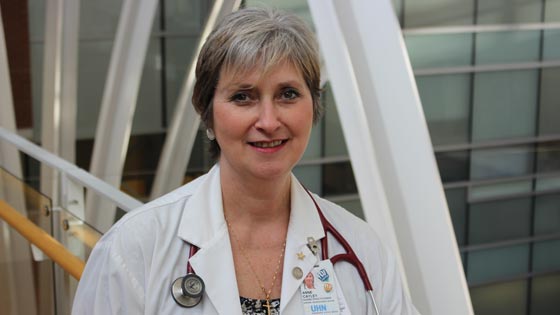
Stroke nurse practitioner Anne Cayley is a member of the team running a pilot project on in-hospital code stroke at Toronto Western, Toronto General, Mount Sinai and Sunnybrook hospitals. (Photo: UHN)
Suffering a stroke is not ideal under any circumstances. But if it's going to happen, you might think that already being admitted in a hospital would improve your chances of having a positive outcome.
However, recent studies suggest the opposite is true. Patients who have a stroke in the community, and are brought to an emergency department, have better outcomes than those who have a stroke while hospitalized for some other reason.
It's for this reason UHN is leading a pilot project that involves developing a standardized protocol for the rapid assessment and treatment of those who develop a stroke while admitted to hospital, as well as developing tools designed to increase awareness among staff about the signs and symptoms of stroke and about the in-hospital code stroke protocol.
"We want to bring awareness to our staff and patients that there are options for patients with stroke who are admitted to hospital for other reasons," says Anne Cayley, a stroke nurse practitioner at the Krembil Neuroscience Centre and a member of the team spearheading the project.
"We need to do this from a patient safety perspective, from an education perspective and from a quality perspective," says Cayley, who adds that about 17 per cent of all strokes happen in a hospital.
11 units at four hospitals
The goal of the in-hospital code stroke project, which is set to begin this month on 11 general medical units spread across Toronto Western, Toronto General, Mount Sinai and Sunnybrook hospitals, is to establish a standardized protocol for action when a stroke occurs in a hospitalized patient. Such a protocol already exists in the emergency departments of most hospitals, including Toronto Western Hospital, a regional stroke centre.
"Usually hospital staff know their patients, so what we need them to look for is a sudden change in condition such as difficulty speaking or weakness on one side of their body, such as their face, arm or leg," says Cayley.
Other signs of stroke include sudden vision loss or double vision, sudden balance problems or an intense sudden and severe headache, usually with one or more of the above symptoms.
The group has developed an eLearning module to educate staff on the signs and symptoms of stroke and what actions should be taken when they do identify a patient. The goal is to get front-line medical staff in all units to alert the Stroke Team on call immediately upon recognition.
"When the stroke nurse is contacted we will triage the call and prioritize what needs to be done," says Cayley. "We will identify whether the case fits the criteria for a code stroke fan-out page to the entire team including the stroke neurologist, fellow, resident and interventional team as well as the flow coordinator."
After imaging takes place, if an ischemic stroke is suspected, a patient could be given the clot-busting drug tissue Plasminogen Activator (tPA), or be transferred to the regional stroke centre for endovascular treatment and removal of a clot limiting blood flow to a part of the patient's brain causing the stroke symptoms. In such cases, endovascular treatment is employed to retrieve the clot.
"Our best-case scenario is to have a process map in place, hospital-wide, that when somebody recognizes a stroke, they can act and call our team right away, similar to what happens with a code blue and a heart attack" says Cayley.
"We want to mimic that so we can give patients the best chance of survival and to optimize functional recovery."
The In-Hospital Code Stroke Quality Improvement pilot project will run over 18 months on inpatient general medical units at the four pilot sites.
